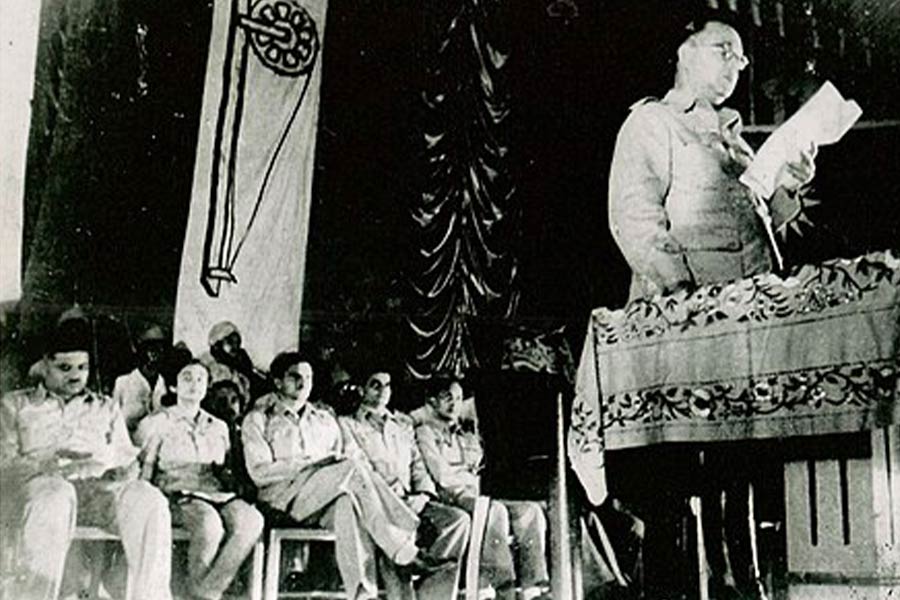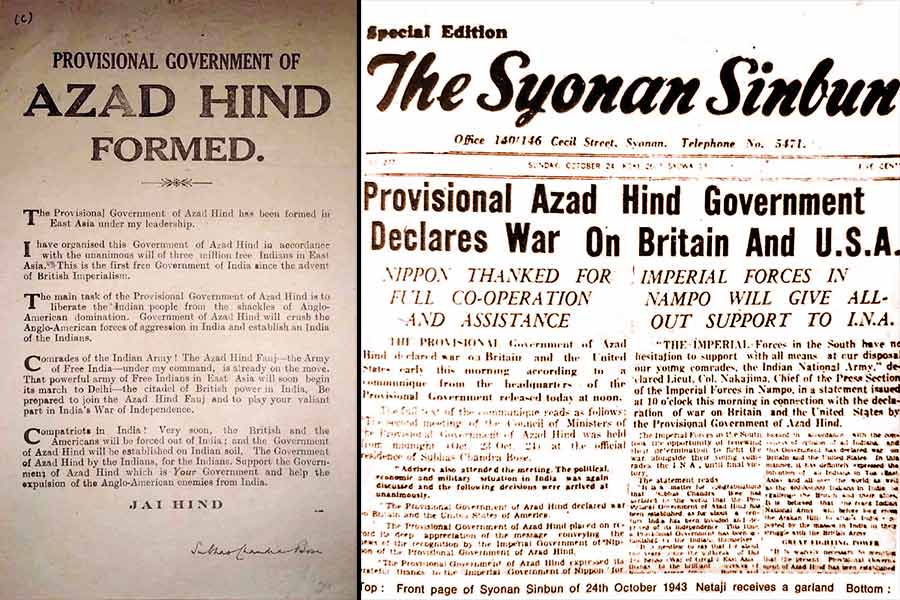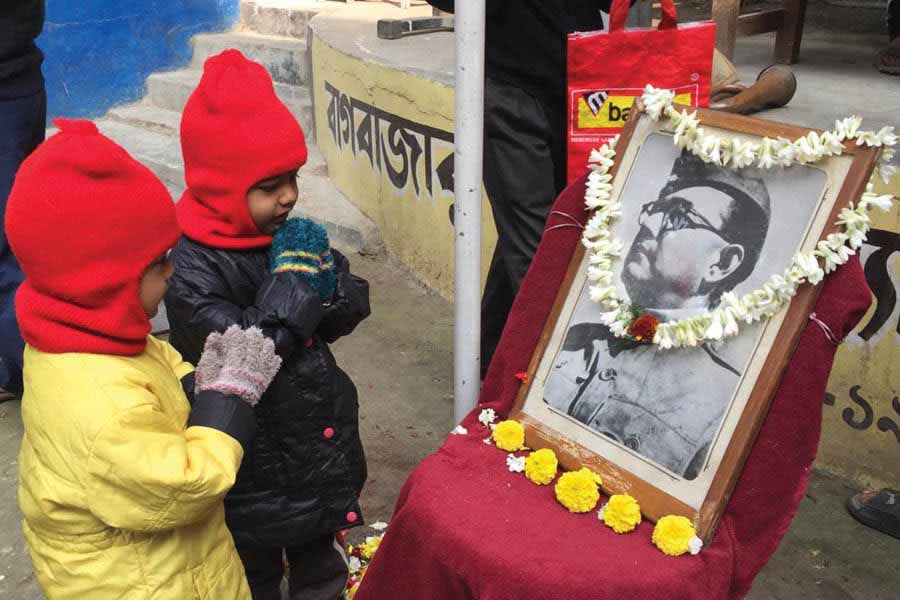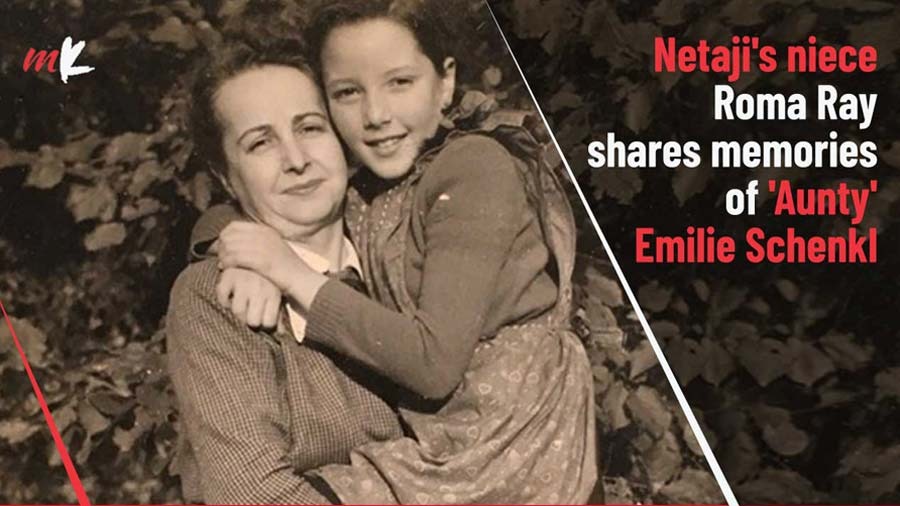Towards the last stage of World War II, from early 1943, the world was watching India with a curious mind – Gandhi’s call of ‘Quit India’ had lost its steam, with the arrest of top Congress leaders and unimaginable suppression executed by the British.
When all tall leaders were in jail, events like the “man-made” famine in Bengal, growth of Muslim communal politics in India, suspicious activities of the Communist Party of India and the shadow of war in the eastern side of India created an insipid atmosphere that clearly pulled down the spirit of common people towards the country’s freedom struggle.

Netaji inspects the guard of honour of Azad Hind Fauj
At that point of time, far from the sight of common people, a dejected and heart-broken Subhas Chandra Bose left Germany, undertaking a highly risky three-month-long underwater submarine voyage to Japan. Bose was by then desperate to free his motherland and even ready to get support from an imperial and ruthless country like Japan. There seemed to be no other way left for him.
In the beginning of 1943, Japan showed interest in Bose and his plan – it was more of a need of Japan than Bose himself. The course of the Second World War was not going in favour of Japan and also all Axis partners across the globe. Japan was desperately looking for an iconic leader from India who could be used as a propaganda poster boy to show their anti-British stand before the world and the arrival of Subhas Chandra Bose was more than a dream come true for Japan.
After changing from a German submarine to a Japanese submarine in Madagascar, Bose landed on the Saban island of Indonesia on May 6, 1943.
Bose met Japanese Prime Minister Tojo in Tokyo on June 10, 1943, and had a long discussion on India’s next move to freedom with the help of Japan.
Bose arrived in Singapore on July 2 to an unimaginable reception from local Indians. His arrival in Singapore was just like a blessing for the soldiers of the nearly disbanded INA as well as for common people.

The office of Azad Hind at Singapore
Bose, a victorious challenger to the Gandhi school of politics in India, coming from Europe was considered a new sunrise of hope to all Indians living in southeast Asia for decades.
July 4, 1943: At the Cathay Theatre of Singapore in front of an august gathering, Rashbehari Bose officially handed over the presidency of the Indian Independence League to Bose.
After being cheered at the civil reception, Bose delivered one of his best speeches of his life, clearly underlining his model of freedom struggle where a direct army invasion into India to crush the British was mentioned.
The joy of common Indians in Singapore found no limits to see such an iconic Indian leader before them. Singapore saw a new sunrise in Bose’s eyes.

Netaji made his point clear that this march of people would suffer all pain till they ensured planting India’s National Flag over the Viceroy House and Red Fort in Delhi
The very next day, that is on July 5, Bose addressed a huge public meeting at Pedang Sports Ground in Singapore in front of the old Supreme Court building. Here, the legendary war cry ‘Chalo Delhi’ ֹwas coined by Bose and it created a mayhem among the already over motivated mass.
However, ‘Chalo Delhi’ was also pronounced by Bose on July 4 at the Cathay Theatre address. On July 6, 1943, at the same venue, Bose and Japanese PM General Tojo jointly received guard of honour from both the INA and Japanese Imperial Army.
All formalities to take over the INA and form an Indian government were complete. It was now clear that an armed Indian army would be led by a former Congress president.

Some war propaganda posters of that time
Finally, on August 26, 1943, Bose officially took charge of INA and renamed it as Azad Hind Fauj, an Indian name much closer to the hearts of every Indian.
There was a mad rush to join Azad Hind Fauj and soon it became an army of people with largely common civilians with no formal military training of any kind.
Azad Hind scripted history by forming one of the only women’s regiments in the Second World War, when Netaji Bose with the help of Dr Lakshmi Swaminathan, a young Tamil doctor, formed a women’s brigade with nearly 1,000 dedicated women soldiers, one of the rarest regiments in the history of the Second World War.
He made his point clear that this march of people would suffer all pain till they ensured planting India’s National Flag over the Viceroy House and Red Fort in Delhi.

The historic Cathay Theatre in Singapore, where the formation of ‘Arzi Hukumat-e-Azad Hind’ was declared. It had an organised army and a fully functioning cabinet
Finally on October 21, 1943, Bose returned to Singapore’s Cathay Theatre and there, he declared the formation of the Provisional Government of Free India, considered a milestone in the history of the Indian freedom struggle.
It was the Second Provisional Government of Free India formed on a foreign soil after one was formed in 1915 during the World War I in Kabul under the leadership of Mahendra Pratap Singh.
The official name of Netaji’s government was given as ‘Arzi Hukumat-e-Azad Hind’, which had an organised army and a fully functioning cabinet.
Dressed in military uniform, Netaji took the oath in the name of God and avowed that now the gory march of Azad Hind would suffer all pain and pangs what may come but it will only stop when the Indian National flag is hoisted atop Delhi’s Viceroy House and Red Fort.

The document of declaration of Free India undersigned by Bose and (right) the cutting of a newspaper article on the formation of the provisional government
“Even after winning freedom, I would always be prepared to shed the last drop of my blood for the preservation of Indian freedom,” vowed the 46-year-old supreme commander of Azad Hind, who once refused to accept a life of luxury of an ICS only to serve his motherland.
In an emotional voice, he read out a proclamation of independence which he had drafted by himself.
Based in Singapore, this government had Netaji Bose as the supreme commander of Azad Hind Fauj and also the Prime Minister, minister of war and foreign affairs and head of the state of the Azad Hind Government.
Netaji also formed a cabinet with five ministers, eight representatives of INA and eight civilian representatives of southeast Asia. The four ministers were Captain Lakshmi Swaminathan, SA Ayer, Lt Col AC Chatterjee and SM Sahay.
An Urdu-Hindi song Sab Sukh Chain Ki Varsha was selected as the anthem of the government. Three Urdu words Itmad, Kurbani and Ittefaq were picked to describe the motto of the Azad Hind.
This new government of Free India formed by Bose got official recognition from the Government of Japan on October 23 the same year.
It soon got official recognition and congratulatory notes from Germany, Italy, Croatia, Manchukuo, Nanking, Philippines, Thailand and Burma.

Another poster of Netaji calling upon his country’s sisters and brothers
On October 24, 1943, he officially announced war against Great Britain and the United States of America. Bose diplomatically remained indifferent to Russia, a country from where he always received a cold shoulder and neglect.
Netaji was able to derive the official control of the Indian islands of Andaman and Nicobar conquered by Japan. However, the control was very limited in power.
With this Netaji’s Provisional Government of Free India had a cabinet, an army and also a territory all making it apparently legitimate before the world outside Japan.
Soon after this, Netaji Bose as the Prime Minister of India attended the Greater East Asia Conference in Tokyo on November 5-6 with other heads of states. Bose was invited there as an observer only.
To mobilise support of the Azad Hind Government, Bose as a state head, paid diplomatic visits to Hong Kong, Shanghai, Manila, Java, Sumatra and Borneo. At Nanking, through a broadcast he surprised all by requesting Chinese Premier Marshal Chiang Kai Shek, a bitter enemy of Japan, to support India’s freedom struggle.
Netaji’s Provisional Government could not achieve much after this. Azad Hind Fauj was neither supported nor treated well by Japan whose own war position was precarious by then.
They provided very nominal arms and artillery and that too only a small section of Azad Hind Fauj. No air support was provided. Other essential war supply ration, transport, logistics, medical, uniform etc were indeed precious.
Except in February 1944, hardly 8,000 Azad Hind soldiers were included with 85,000-plus Japanese army to invade Imphal and Kohima they were not seen much in front. Captain Malik could hoist Azad Hind’s flag at a place named Moirang in Manipur, which was freed from the British Army. Surprisingly, Netaji then at Rangoon did not visit Moirang at that moment.
In January 1944, the headquarters of Azad Hind was moved to Rangoon from Singapore. However, a large part of its army was not mobilised there.
Finally, after Japan’s surrender on August 15, 1945, Netaji also left Singapore to a never disclosed destination. He before leaving issued his last order as head of the Provisional Govt of Free India to his all soldiers to keep their courage intact and be disciplined soldiers dedicated to their motherland.
The dream drawn by Netaji at the Cathay Theatre of Singapore in July-Oct of 1943 finally came to an end on that day.
However, the objective of this Provisional Government of Free India was finally shaped up in 1946 when Naval Mutiny broke out in Bombay and Karachi deriving all inspiration from Netaji Bose and his Azad Hind.








